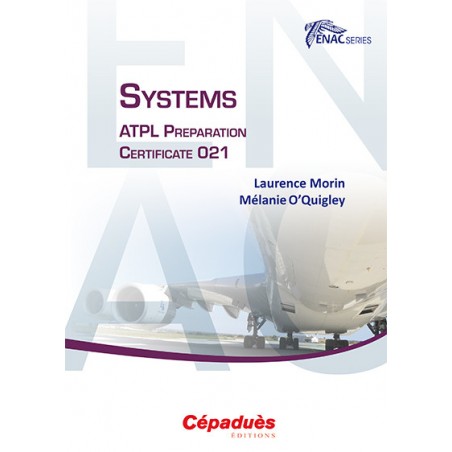





This book is aimed at future pilots willing to study Systems (021) within the framework of ATPL Theoretical Certificates. It complies with EASA's Learning Objectives for the 021 Certificate. The chapters are all illustrated to facilitate the reader's comprehension. At the end of each chapter, the reader will find key-points highlighting the most important notions.
Laurence Morin is engineer and head of pilot theoretical training at the ENAC. She teaches Airframe, Systems and Electricity to future pilots and engineers at the ENAC.
Mélanie O'Quigley is a former student pilot of the ENAC.

Commande avant 16h,
expédié le jour même (lu. - ve.)

Livraison express sous 48h.
This book is aimed at future pilots willing to study Systems (021) within the framework of ATPL Theoretical Certificates. It complies with EASA's Learning Objectives for the 021 Certificate. The chapters are all illustrated to facilitate the reader's comprehension. At the end of each chapter, the reader will find key-points highlighting the most important notions.
Laurence Morin is engineer and head of pilot theoretical training at the ENAC. She teaches Airframe, Systems and Electricity to future pilots and engineers at the ENAC.
Mélanie O'Quigley is a former student pilot of the ENAC.
| Référence : | 1116 |
| Nombre de pages : | 96 |
| Format : | 17x24 |
| Reliure : | Broché |
| Rôle | |
|---|---|
| Morin Laurence | Auteur |
| O'Quigley Mélanie | Auteur |
Table of CONTENTS
INTRODUCTION
PREAMBLE
1 Types of failure
2 Probabilities of occurrence
3 Conclusion
CHAPTER 1 : HYDRAULIC SYSTEM
1Basic notions
1.1 Hydrostatic pressure
1.2 Pascal’s Principle
1.3 Force-pressure relation
1.4 Power
1.5 Passive and active hydraulic system
1.6 Advantages and disadvantages of hydraulic power
2 Fundamental Principle of a Hydraulic System.
2.1 Block Diagram
2.2 Specific points: redundancy and indications
3 Constant Flow System
3.1 Presentation of the constant flow system
3.2 Disadvantages of constant flow systems
4 Variable Flow Systems
4.1 Presentation of the variable flow system
4.2 Advantages of the variable flow system
5 Hydraulic fluids
5.1 Important Definitions and Properties
5.2 Hydraulic fluids
6 Components
6.1 Reservoir
6.2 Pumps
6.3 Filters
6.4 Accumulators
6.5 Valves
6.6 Hydraulic servo controls
7 Hydraulic Motors
CHAPTER 2: PNEUMATIC SYSTEM
1 General
2 Air sources
2.1 Engine Bleed
2.2 APU Bleed
3 Pneumatic system
CHAPTER 3: AIR CONDITIONING AND PRESSURIZATION (ATA 21)
1 Principle of air conditioning and pressurization
2 Air conditioning
2.1 General
2.2 Basic principle
2.3 Single-cycle pack (or “turbofrein”)
2.4 Dual-cycle pack (or “bootstrap”)
2.5 Water separator
2.6 Vapour cycle system
3 Ventilation
3.1 Quantity of air provided per occupant
3.2 Air circulation in the fuselage
3.3 Air quality
3.4 Forced ventilation
3.5 Controls
4 Pressurization
4.1 Pressurization = life
4.2 The other consequences of pressurization
4.3 Principle
4.4 More about the “Outflow valve”
4.5 The two types of OFV
4.6 Protections
CHAPTER 4: OXYGEN (ATA 35)
1 Sources of oxygen
1.1 Gaseous oxygen
1.2 Chemical oxygen
1.3 Pros and cons
2 Gaseous oxygen systems
2.1 Flight crew system
2.2 Passenger system
3 Precautions
3.1 Fire risk
3.2 Pressure-related risks
3.3 Consequences
4 Oxygen masks
4.1 Flight crew masks
4.2 Passengers’ oxygen masks
4.3 Crew portable protective breathing equipment (cabin crew and flight crew)
CHAPTER 5: ICE AND RAIN PROTECTION (ATA 30)
1 Icing
1.1 Definition
1.2 Ice formation
1.3 Additional considerations
2 Danger!
3 Detection
3.1 On the ground
3.2 In flight
4 Treatments definitions
4.1 De-icing
4.2 Anti-icing
5 Treatment on the ground
5.1 On-field preventive measures
5.2 On-field remedial measures.
5.3 One-step de-icing and anti-icing.
5.4 Precautions
5.5 Procedure
5.6 Protection times
6 In-flight treatments
6.1 Hot air thermal systems
6.2 Heating resistor thermal systems
6.3 Mechanical systems
6.4 Liquid-based systems
6.5 Synthesis
7 Rain
7.1 Windshield wipers
7.2 Rain repellent
7.3 Windshield coating
APPENDIX 1: EXAMPLES OF ALTITUDE HYPOXIA INCIDENTS (SLOW DEPRESSURIZATIONS)
APPENDIX 2: EU-OPS
APPENDIX 3: I.S. UNIT
Livres de l'auteur Laurence Morin
Livres de l'auteur Mélanie O'Quigley